
Bikes on Boats:
Ferries are Bike-friendly for
Everyday Transportation
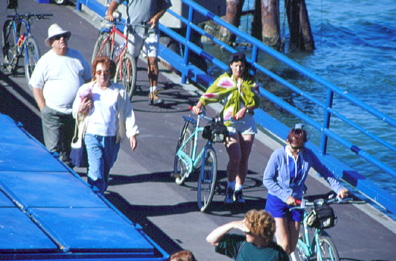 |
| Ferries
are an extension to bike paths that end at the shoreline |
The San Francisco Bay Area Water
Transit Authority (WTA) has proposed a plan to expand the Bay Area’s
ferry system that ought to make cyclists pretty happy. Not only has
the WTA recommended reaching as many as eight additional communities
around the Bay Area by ferry, but it plans to mandate bike-friendly
boat designs to give cyclists an attractive option for a car-free
commute.
Bike connections across the Bay
currently depend on limited access to existing bus or rail. BART
prohibits bikes during peak hours and buses can only carry two bikes
at a time. By contrast, ferries carry 25 or more bikes with no
problem. On a busy weekend day, ferries might carry 100 or more
bikes on a single trip.
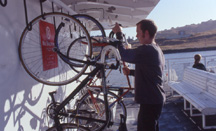 |
| The
Water Transit Authority’s new fleet design calls for
protected bike storage on all boats. |
Making the commute for cyclists
even better, the WTA’s future fleet of boats would guarantee bike
parking for a minimum of 10 percent of passengers. This bike parking
would be protected from corrosive salt spray and made immune to
jostling by providing some sort of restraint for each bike.
Commuters and Tourists Travel by
Ferries and Bikes
Presently, four out of five San
Francisco tourists board a ferry during their stay. San Francisco
Bicycle Coalition (SFBC)’s Program Director,
Josh Hart, said, "The WTA and individual transit providers
could do a great job of promoting bike routes." In doing so,
transit providers could market to another source of business and
promote biking at the same time.
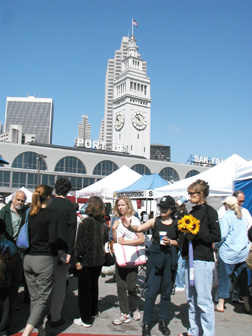 |
| The
Farmer’s Market at the SF Ferry Building: an attractive
destination or pit stop for ferry riders |
Mr. Hart commuted to his job in
downtown San Francisco from Fairfax via bicycle for several years.
He typically biked the scenic 30-minute route from his house to the
Larkspur ferry terminal, then enjoyed the ride to San Francisco’s
Ferry Building. Now that he lives in San Francisco, he uses ferries
to give him an extra boost to recreational rides.
Marin County Bicycle Coalition (MCBC)’s
Outreach Coordinator, Frances Barbour Hayden, said that the MCBC
recently performed an on-board survey of passengers returning from
San Francisco to Larkspur. Out of 386 returned surveys, 18 percent
of the passengers said they would consider commuting by bicycle. Ms.
Hayden said, "You have access to all your senses on a bike--not
so in a car. A lot of people just don’t know they have other
options. They have the concept that [biking] is unsafe."
Both the MCBC and the SFBC work to
educate people on how to safely commute by bike. MCBC contracts with
22 schools in the Safe Routes to Schools program and also focuses on
educating seniors. SFBC offers training on urban cycling and has
successfully advocated for a major increase in bike lane striping.
Emphasizing the need for bike lanes, Ms. Hayden said, "Bikes on
sidewalks is not ideal, but it’s better than battling semi-trucks
if that’s the option."
Bike Stations
Marin County
Hoping to increase the number of
bike commuters between Larkspur and San Francisco, Ms. Hayden
spearheads the campaign to create a Bike Station at the Larkspur
Ferry Terminal. She notes that there is no bicycle support within
five miles of the Larkspur terminal, which may discourage some
people from biking.
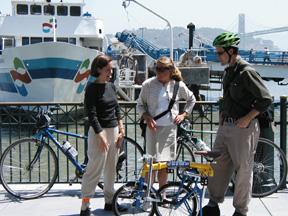 |
| SFBC’s
Joshua Hart demonstrates his folding "Breezer"
bicycle, good for avoiding salt spray on ferries without
covered bike parking, to WTA staffer Heidi Machen (l) and
MCBC’s Frances Barbour Hayden (middle) |
"Bike support is just like a
filling station for a car," she explained. In other words, a
Bike Station attendant could help cyclists with minor mechanical
problems such as filling a tire, changing a flat, or simply offer
helpful advice or directions for the best bike route. A Bike Station
would offer secure, protected parking for bikes and could offer bike
rentals and concessions.
The idea of a Bike Station is not
new to the Bay Area: Palo Alto’s train station and Berkeley’s
downtown BART opened such facilities within the last couple of
years. Another Bike Station is scheduled to open within the next
couple of years at Caltrain’s 4th and King station in San
Francisco. Both the Golden Gate Bridge District’s Board and its
Ferry Advisory Committee have conceptually approved Larkspur Ferry
Terminal and San Rafael as locations for Marin County Bike Stations.
San Francisco Ferry Building
Ms. Hayden acknowledged,
"There is more of a demand [for a Bike Station in San
Francisco] than we would ever have in Marin. For instance, the San
Francisco Ferry Building is served by the greatest number of transit
options of anywhere in the Bay Area (perhaps of anywhere within
California!), including various bus lines, Amtrak and Muni rail, and
the ferry, not to mention pedestrians, skaters, and cyclists. The
historic Agricultural Building, at Embarcadero and the foot of
Mission Street, could be an ideal location for a Waterfront
Transportation Center to complement the transit accessibility with
ticketing and information; it already houses Amtrak. This Waterfront
Transportation Center could be an ideal location for a Bike Station
and could even offer space for City Car Share.
New and Improved Embarcadero
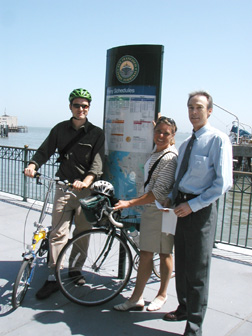 |
| Joshua
Hart (l) checks out the ferry schedule from San Francisco
Ferry Building with Frances Barbour Hayden and Senior
Waterfront Planner Dan Hodapp (r) |
A renovated Ferry Building and
Farmers’ Market — which is open two days a week (Tuesdays and
Saturdays), Pac Bell Park, the Muni F-line, new housing, and public
art such as the Claus Oldenburg giant Cupid’s Span sculpture, make
the Embarcadero a more attractive destination for visitors.
Execution of the Water Transit Authority’s plan to expand Bay Area
ferry routes would increase the daily passenger trips from ferries
which total approximately 11,000 to approximately 36,000 over the
next 15 years. According to the Port of San Francisco’s Senior
Waterfront Planner Dan Hodapp, the Port is poised to triple the
number of ferry berths to accommodate the expected increase in ferry
traffic during the next fifteen years as well as to add to San
Francisco’s emergency response capabilities.
"From Candlestick Park to the
newly renovated Crissy Field and the Golden
Gate Bridge, there are great options for people arriving by
ferry," said Mr. Hodapp. Design features envisioned for the
Port’s future, such as wider ramps, coupled with the WTA’s new
fleet designs, including side and front loading, will allow people
on bikes and wheelchairs to board and unboard faster. Mr. Hodapp
said that the Port had increased the number of bike racks along the
waterfront so that nearly 500 bikes could park along the Embarcadero
without having to seek out a street sign or parking meter. During
baseball games, Pac Bell Park offers a valet bike parking option
operated by the San Francisco Bicycle Coalition.
Of past and future progress on promoting
alternative transportation such as ferries and bikes, Mr. Hart said,
"Giving people choices works! People want to get out of their
cars, but forcing them to do so won’t work."